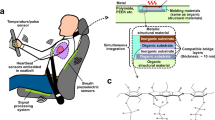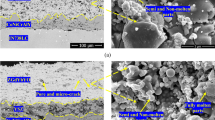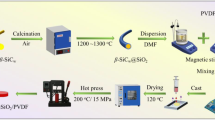Abstract
The strength of bonding at epoxy/SiO2 interface and its susceptibility to environmental degradation have profound impact on the lifetime and reliability of microelectronic devices. The incorporation of hybrid film at epoxy/SiO2 interfaces has been shown to alleviate this challenge, but the working time to produce these highly-adherent hybrid films on silicon has been limited to ~10 min. In this work we demonstrate that, by lowering sol–gel aging temperature to 5 °C, the processing window for producing highly-adherent hybrid films on silicon can be extended to more than 6 h. In addition to the extended processing time, an Arrhenius type relationship between sol–gel aging temperature and the optimal sol–gel aging time was observed, with an overall sol–gel reaction activation energy of approximately 2.03 eV/atom that includes both hydrolysis and polycondensation. The enhanced interfacial adhesion was explained in terms of the graded hybrid film structure as determined by X-ray photoelectron spectroscopy depth profiling. The work has significant implications for the successful integration of hybrid film strategy in device packaging technologies.
Graphical Abstract
Fracture energy of epoxy/hybrid-film/SiO2 structures with films prepared at different sol–gel aging times and temperatures. Black, red and blue curves show fracture energy as a function of sol-gel aging time for solutions aged at 25, 15 and 5 °C respectively. Grey dashed line indicates Gc = 60 J/m2 while orange dot-dash line represents the adhesion of epoxy/SiO2 interface in the absence of the hybrid film.








Similar content being viewed by others
References
Lane MW, Snodgrass JM, Dauskardt RH (2001) Environmental effects on interfacial adhesion. Microelectron Reliab 41:1615–1624
Sharratt BM, Wang LC, Dauskardt RH (2007) Anomalous debonding behavior of a polymer/inorganic interface. Acta Mater 55:3601–3609
Kook S-Y, Dauskardt RH (2002) Moisture-assisted subcritical debonding of a polymer/metal interface. J Appl Phys 91:1293–1303
Hohlfelder RJ, Maidenberg DA, Dauskardt RH (2001) Adhesion of benzocyclobutene-passivated silicon in epoxy layered structures. J Mater Res 16:243–255
Snodgrass JM, Pantelidis D, Jenkins ML, Bravman JC, Dauskardt RH (2002) Subcritical debonding of polymer/silica interfaces under monotonic and cyclic loading. Acta Mater 50:2395–2411
Kook S-Y, Snodgrass JM, Kirtikar A, Dauskardt RH (1998) Adhesion and reliability of polymer/inorganic interfaces. J Electron Packag 120:328
Lane MW, Liu XH, Shaw TM (2004) Environmental effects on cracking and delamination of dielectric films. IEEE Trans Device Mater Reliab 4:142–147
Dauskardt RH, Lane M, Ma Q, Krishna N (1998) Adhesion and debonding of multi-layer thin film structures. Eng Fract Mech 61:141–162
Wiederhorn SM (1967) Influence of water vapor on crack propagation in soda-lime glass. J Am Ceram Soc 50:407–414
Wiederhorn SM, Fuller ER, Thomson R (1980) Micromechanisms of crack growth in ceramics and glasses in corrosive environments. Metal Sci 14:450–458
Chan MKV, Williams JG (1983) Slow stable crack growth in high density polyethylenes. Polymer (Guildf) 24:234–244
Tonyali K, Brown HR (1986) On the applicability of linear elastic fracture mechanics to environmental stress cracking of low-density polyethylene. J Mater Sci 21:3116–3124
Atanacio AJ, Latella BA, Barbé CJ, Swain MV (2005) Mechanical properties and adhesion characteristics of hybrid sol–gel thin films. Surf Coat Technol 192:354–364
Dubois G, Volksen W, Magbitang T, Sherwood MH, Miller RD, Gage DM, Dauskardt RH (2008) Superior echanical properties of dense and porous organic/inorganic hybrid thin films. J Sol-Gel Sci Technol 48:187–193
Julian B, Gervais C, Cordoncillo E, Escribano P, Babonneau F, Sanchez C (2003) Synthesis and characterization of transparent PDMS-metal-oxo based organic-inorganic nanocomposites. Chem Mater 15:3026–3034
Tsai M-H, Ko C-J (2006) In situ formation, surface characteristics, and interfacial adhesion of poly(imide siloxane)/tantalum oxide hybrid films. Surf Coat Technol 201:4367–4371
Giachino M, Dubois G, Dauskardt RH (2013) Heterogeneous solution deposition of high-performance adhesive hybrid films. ACS Appl Mater Interfaces 5:9891–9895
Giachino M, Dubois G, Dauskardt RH (2015) Molecular design for moisture insensitivity of compositionally graded hybrid films. ACS Appl Mater Interfaces 7:6812–6818
Oliver MS, Blohowiak KY, Dauskardt RH (2010) Molecular structure and fracture properties of ZrOX/Epoxysilane hybrid films. J Sol-Gel Sci Technol 55:360–368
Park ES, Ro HW, Nguyen CV, Jaffe RL, Yoon DY (2008) Infrared spectroscopy study of microstructures of poly (silsesquioxane) s. Chem Mater 20:1548–1554
Iacopi F et al (2006) Short-ranged structural rearrangement and enhancement of mechanical properties of organosilicate glasses induced by ultraviolet radiation. J Appl Phys 99:053511
Mu J, Liu Y, Zheng S (2007) Inorganic–organic interpenetrating polymer networks involving polyhedral oligomeric silsesquioxane and poly(ethylene oxide). Polymer (Guildf) 48:1176–1184
Liu W, Yang C, Chen W, Dai B-T, Tsai M-S (2002) The structural transformation and properties of spin-on poly (silsesquioxane) films by thermal curing. J Non Cryst Solids 311:233–240
Xue G, Ishida H, Koenig JL (1986) Chemical reactions in the bulk of the epoxy-functional silane hydrolyzate. Die Angew Makromol Chem 140:127–134
Armelao L et al (2006) Structural evolution upon thermal heating of nanostructured inorganic—organic hybrid materials to binary oxides MO2–SiO2 (M) Hf, Zr) as evaluated by solid-state NMR and FTIR spectroscopy. Chem Mater 18:6019–6030
Wallace WE, Guttman CM, Antonucci JM (2000) Polymeric silsesquioxanes : degree-of-intramolecular-condensation measured by mass spectrometry. Polymer (Guildf) 41:2219–2226
del Monte F, Larsen W, Mackenzie JD (2000) Chemical interactions promoting the ZrO2 tetragonal stabilization in ZrO2–SiO2 binary oxides. J Am Ceram Soc 83:1506–1512
Ma Y, Jia P, Li X, Liu N, Ma Y (2012) Synthesis of the ZrO2–SiO2 microspheres as a mesoporous candidate material. J Porous Mater 19:1047–1052
Selvaraj M, Kim BH, Lee TG (2005) FTIR studies on selected mesoporous metallosilicate molecular sieves. Chem Lett 34:1290–1291
Acknowledgments
We thank Semiconductor Research Corporation (SRC) for their financial support under task ID: 2478.001.
Author information
Authors and Affiliations
Corresponding author
Rights and permissions
About this article
Cite this article
Xiao, Q., Giachino, M. & Dauskardt, R.H. Controlling kinetics of heterogeneous sol–gel solution for high-performance adhesive hybrid films. J Sol-Gel Sci Technol 77, 620–626 (2016). https://doi.org/10.1007/s10971-015-3891-1
Received:
Accepted:
Published:
Issue Date:
DOI: https://doi.org/10.1007/s10971-015-3891-1




